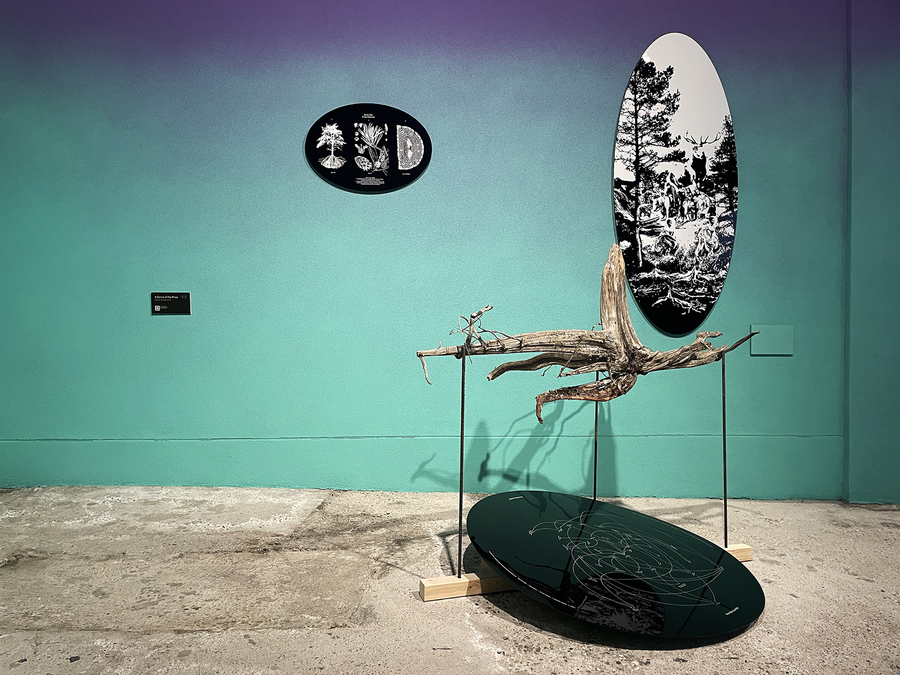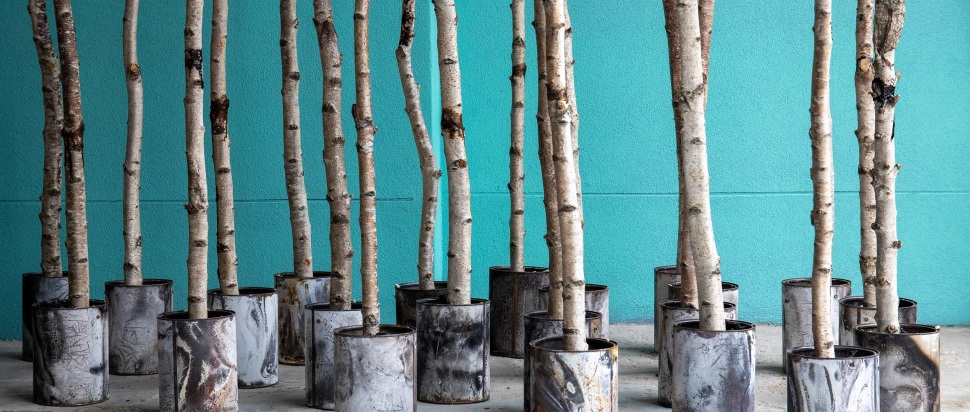A Fragile Correspondence: Scotland at the Venice Architecture Biennale
Our design correspondent heads to Venice to explore A Fragile Correspondence, Scotland's presentation at the Architecture Biennale
How can a closer relationship between land and language help architecture be more attuned to the environment in which it operates? Highlighting cultures and languages that have a close affinity with the landscapes of Scotland, A Fragile Correspondence explores alternative perspectives and new approaches to the challenges of worldwide climate emergency at this year's Venice Architecture Biennale.
The 2023 Biennale opened to an enthusiastic consensus about what its curator – the Scottish-Ghanaian architect Lesley Lokko – has achieved, a strikingly original and politically engaged festival where contributions are as diverse in presentation as they are in concept.
Some of the most exciting and successful projects seek to explore decolonisation and decarbonisation at a deeper level than we have become accustomed to. Many focus on hopeful futures, such as Francis Kéré’s West African examples where this quote resonates: “Just because our history was interrupted by others, does not mean our future has to be.”
The Giardini features national pavilions where each country advocates for their take on what matters most in architecture. This is traditionally the most Eurovision part of the Biennale and 2023 does not disappoint. France exhibits a giant disco ball aimed at 'reawakening our desires for utopia,' while Finland declares the 'death of the flushing toilet' with a practical solution and a very nicely considered presentation.
Over at the Arsenale, the powerful aesthetic coupled with the rigour of Lokko’s immersive curatorial approach, delivers a more sombre, contemplative experience. In many respects, Lokko’s theme The Laboratory of The Future is characterised by a narrative of loss; the destructive consequences of colonialism, the literal erasure of cultures – as well as the intention to erase in contemporary Xinjiang. This is tempered in a wider sense by the many contributions from Lokko’s ‘Guests From The Future’ who embody just how incomplete the story of architecture has been historically, presenting new visions and approaches.
Nestled in between the Giardini and the Arsenale is A Fragile Correspondence, Scotland’s contribution to the 18th International Architecture Exhibition. It is one of nine international Collateral Events, and the Scottish team have curated and designed a distinctive, multi-layered, meditation on the imbricated relationships of language, landscape and architecture.
The diversity of voices that characterises the exhibitions of the wider Biennale is mirrored here with a curatorial team and participating practitioners that bring together a variety of experiences and perspectives. The exhibition is a collaboration between Architecture Fringe, led by Neil McGuire and Andy Summers; -ism magazine, an independent publication based in Glasgow where Kristina Enberg, Amy McEwan, Aoife Nolan and Alissar Riachi all share a desire for bold and critical reflection on the built environment; and /other [pronounced ‘slash-other’] a collective of POC architecture graduates and creatives including Alyesha Choudhury, Carl C.Z. Jonsson and Mia Pinder-Hussein, who centre the marginalised individual within architectural discourses.
Commissioned by the Scotland + Venice partnership, the exhibition is situated at the old Arsenale Docks where the Venetian waves lap against the gently fading terracotta-coloured buildings. It’s a fitting site for a show that acknowledges how international forces of trade and extraction shape our land. The curatorial proposition centres on the question 'by re-establishing our dialogue with the land, how can we value exchange over extraction and equality over dominance; how can we create a more reciprocal connection with the land?' It demonstrates in what ways our landscapes are constantly transmitting information – if we choose to see and listen.
From the forests around Loch Ness, the seashore of the Orkney archipelago and the industrialised remnants of the Ravenscraig steelworks, the project takes us on a journey through three Scottish landscapes; the Highlands, Islands and Lowlands. Selected writers, artists and architects, in correspondence with these landscapes, have explored topics distinctly rooted in place. This thoughtfully composed exhibition outlines how these issues share a global relevance to the cultural, ecological and climatic issues that we face.
The creative responses to the questions posed by A Fragile Correspondence are displayed throughout the exhibition in the form of sculpture and installation, photography, film and sound. The materials used reflect aspects of the various landscapes with timber supporting the work exploring Loch Ness; straw and a palette of natural materials helping to frame Orkney, and an emphasis on metalwork contextualising Ravenscraig.
The curators propose that through an expanded way of thinking about language and land, designers can approach issues like climate emergency with a new vigour. As co-curator and editor of -ism magazine Aoife Nolan explains, “A Fragile Correspondence celebrates and shapes the way in which we see the world highlighting some key words from some diverse languages that have an affinity with the Scottish landscape and offer alternative perspectives, and world views.”
For example, the 19th century Scots word barescrape means very poor land yielding little return for labour. Thinking of this at Ravenscraig where vegetation grows on “the scraps and scrapes of post-industrial clearance” prompts Dr Amanda Thomson to ask, “How might we find ways to encompass, even celebrate what might at first appear incidental, accidental?” She notes that the pioneer birches and other species of trees that cover the site are so important for carbon capture and research has found that silver birch leaves can filter out particles from polluted air.

A Dance of the Pines by Dele Adeyemo, from A Fragile Correspondence. Photo: Robb Mcrae
Organised into four distinct areas, the installation firstly introduces representations of Loch Ness and explores ideas about alternative forms of ownership and land stewardship. It begins with the premise that the Highlands are the genesis of a romanticised modern world tourism, and asks “how does internationalised capital and commercial extraction affect the biodiversity, cultural identity and environmental sustainability of the land in a local context?”
Moving to Orkney, the focus is on the space that is both water and land, the foreshore. The exhibition highlights the foreshore’s historic use by humans stretching back to the neolithic era describing how Orcadians have, for centuries, negotiated with local forces of nature and in particular, the sea. With references to Norn and Orcadian Scots, precious and reciprocal forms of communication are celebrated.
The Lowland site of Ravenscraig explores the erasure of the contemporary landscape through the lens of flora and fauna. Stories of labour, community economy, regeneration, dereliction, and memory are condensed in its history. The exhibition presents Ravenscraig’s current condition, and a more nuanced relationship and understanding between a human-made and resurgent natural landscape.
A fourth space brings together materials from all three locations in The Lexicon; a physical wall display and digital touchscreen interface where audiences are invited to interact with the text and resources, and contribute their own words and descriptions for land or places that are important to them. Throughout the installation audio speakers transmit vocal narrations and field recordings from all three locations.
This poignant and impactful exhibition succeeds in elaborating how our existence relies on a close relationship with the landscapes that sustain us. It also outlines how our understanding of the natural world around us is fragile, and suggests how a closer relationship between land and language can help architecture be more attuned to the environment in which it operates.
Ultimately, most of the 2023 Biennale is, in one way or another, about resources, which makes the announcement that Scotland’s future participation is being paused for a period of ‘review and reflection’ worrying. Scotland + Venice has been a powerful driver of perceptions of our culture over its 20 year run. It has a proven track record of increasing opportunity and access to professional development for those who participate. As Lesley Lokko notes in her introduction at the Arsenale, “participation in the Biennale is predicated on two things: imagination and the means to display it… individuals, through the state, control the circumstances in which creativity flourishes.”
A Fragile Correspondence, Docks Cantieri Cucchini S. Pietro di Castello, Venice, until 26 Nov (closed Mon), 11am-7pm
afragilecorrespondence.org
